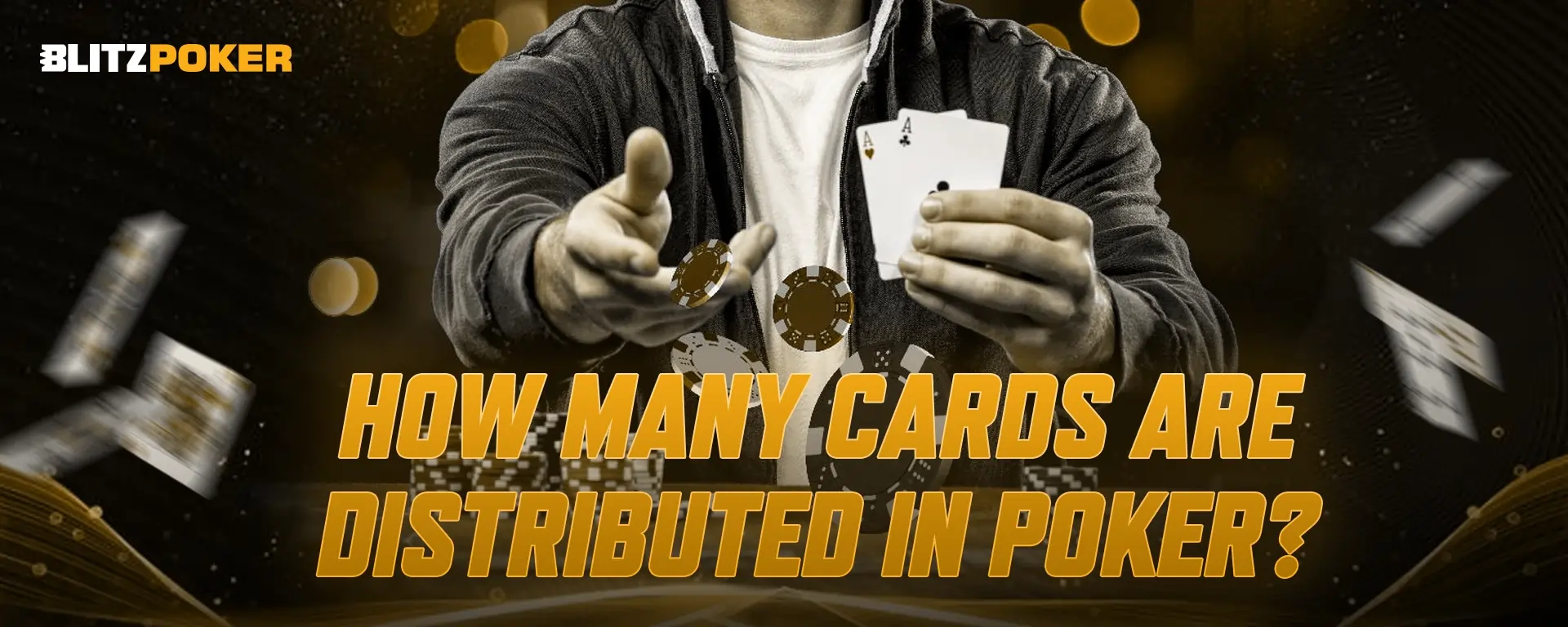How Many Cards Are Distributed in Poker
When playing poker, the number of cards you receive depends on the version of the game you’re playing. From Texas Hold’em to Omaha, each poker variation has its own way of dealing cards. Understanding these differences is essential to improving your game. In this article, we’ll explain how many cards are distributed in the most popular poker variations, giving you the knowledge you need to make better decisions at the table. Ready to put your skills to the test? Sign up at BLITZPOKER and experience thrilling gameplay and exclusive features that take your poker experience to the next level.
How Do You Distribute Cards in Poker?
In poker, dealing cards is quite simple. The dealer, or the designated player, shuffles the deck to mix the cards well. Dealing starts with the player on the dealer’s left and moves clockwise. Each player gets one card at a time, and this continues until everyone has the right number of cards for the game. For instance, in Texas Hold’em, players get two cards each. In some games like Texas Hold’em, a burn card is taken off the top before dealing the community cards to prevent cheating and add randomness.
How Many Cards Are Distributed in Poker?
In poker, the number of cards dealt to each player varies depending on the game variant. The total number of cards can change depending on the specific rules of the game being played. Here’s how many cards are distributed in different poker variants:
1. Texas Hold’em
Texas Hold’em is the most popular poker variant worldwide. Here’s how the cards are dealt:
- Hole Cards: Each player receives two private cards, known as “hole cards,” which are dealt face down. These cards are visible only to the player to whom they are dealt.
- Community Cards: A total of five community cards are dealt face up in the centre of the table. There are 3 stages in which the community cards are revealed:
- The Flop: The first three community cards are dealt face up after the first round of betting.
- The Turn: The fourth community card is dealt face up after the second round of betting.
- The River: The 5th and final community card gets dealt face up after the 3 betting round.
- Objective: Players must create the best five-card hand using any combination of their two hole cards and the five community cards.
2. Omaha
Omaha is similar to Texas Hold’em but with more complexity due to the additional hole cards:
- Hole Cards: Each player receives four private cards, known as hole cards, dealt face down.
- Community Cards: Five community cards are dealt face up in the centre of the table, just like in Texas Hold’em.
- Unique Rule: Unlike Texas Hold’em, in Omaha, players must use exactly two of their four hole cards and three of the five community cards to make their best five-card hand.
- Objective: This rule adds an extra layer of strategy, as players must carefully consider which two hole cards will best combine with the community cards to form a strong hand.
3. Seven-Card Stud
Before Texas Hold’em took over, Seven-Card Stud was the dominant poker game. Here’s how it works:
- Starting Deal: Each player is initially dealt three cards—two face down (called hole cards) and one face up.
- Subsequent Deals: Over the course of the hand, four more cards are dealt to each player which makes it a total of 7 cards:
- Fourth Street: One card is dealt face up.
- Fifth Street: Another card gets dealt in a face up way.
- Sixth Street: The final face-up card is dealt.
- Seventh Street (The River): The last card is dealt face down.
- Objective: Players now have a total of seven cards (three face down, four face up). The goal is to make the best possible five-card hand using these seven cards.
- No Community Cards: Unlike Texas Hold’em and Omaha, there are no community cards in Seven-Card Stud; all cards are individual to each player.
4. Five-Card Draw
Five-Card Draw is one of the simplest forms of poker and often the first game people learn:
- Initial Deal: Each player is dealt five cards, all face down.
- The Draw: After the first round of betting, players have the opportunity to improve their hand by discarding any number of cards (from one to five) and drawing new ones from the deck to replace them.
- Objective: The goal is to make the best possible five-card hand after the draw. Unlike other variants, there’s only one round of drawing and one final round of betting before the showdown.
5. Razz
Razz is a lowball variant of 7 Card Stud, where you aim to make the lowest possible hand:
- Starting Deal: Each player is dealt three cards—two face down and one face up.
- Subsequent Deals: Over the course of the hand, four more cards are dealt:
- Fourth, Fifth, and Sixth Streets: Each of these streets sees one more card dealt face up.
- Seventh Street (The River): The final card gets dealt face down.
- Objective: The best possible hand in Razz is A-2-3-4-5, known as the “wheel.” The goal is to avoid pairs and high cards, making the lowest possible five-card hand from the seven cards dealt.
6. Pineapple
Pineapple is a fun and slightly quirky variant of Texas Hold’em:
- Hole Cards: Each player is dealt three hole cards instead of the usual two.
- Discard: Before any community cards are dealt, players must discard one of their three hole cards, leaving them with two.
- Community Cards: The game then proceeds like Texas Hold’em, with five community cards dealt in the same stages—The Flop, The Turn, and The River.
- Objective: Players must make the best five-card hand using their two remaining hole cards and the community cards.
